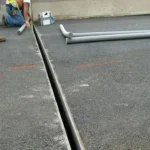If your commercial building has a concrete floor, you’re likely familiar with the importance of expansion joints. These joints are essential for allowing the natural expansion and contraction of concrete due to temperature changes. Without them, large cracks could form across your floor, leading to expensive damage. Expansion joints are designed to absorb and dissipate stress caused by this movement, but in extreme cases, even the joints themselves can crack.
It’s important to recognize that cracked expansion joints are actually performing their intended function by protecting the concrete slabs. Repairing or replacing cracked expansion joints is a much simpler and cost-effective task compared to replacing the concrete slabs themselves. Therefore, it’s crucial to address cracked joints as soon as they are noticed to prevent further damage to both the joints and the concrete floor.
Repairing or replacing expansion joints is best handled by professionals. Without the proper knowledge, materials, and tools, attempting repairs on your own can lead to more damage and increased costs. Hiring a professional ensures that the issue is properly assessed and fixed, helping to prevent future problems.
**Why Do Expansion Joints in Concrete Crack?**
The main cause of cracked expansion joints is temperature fluctuations. Often, premature cracking is the result of poor planning or the use of incorrect materials. Expansion joints are designed to accommodate movement caused by temperature changes, which includes expansion when temperatures rise and contraction when temperatures drop.
Concrete is a complex material with specific properties that engineers consider when designing structures. A key design technique involves specifying controlled expansion joints at precise intervals to allow for this movement.
Contrary to what some may believe, concrete is not a static material—it moves predictably based on temperature. Engineers account for this movement by calculating the width and placement of expansion joints. For example, 100 linear feet of concrete at 100 degrees Fahrenheit expands by 0.66 inches. At 160 degrees, it expands by 1.06 inches. These calculations are essential for ensuring that the concrete remains intact under temperature fluctuations.
Aside from temperature, another leading cause of cracked expansion joints is poor material selection. The materials used must be compatible with the type of concrete and the environmental conditions. For instance, certain concrete mixtures contain corrosive additives that can be harmful to the joint material. Additionally, some expansion joint materials aren’t suitable for environments where contaminants like oil and fuel are present.
Common Expansion Joint Materials
Understanding the materials used for expansion joints is key to ensuring their longevity. Some common materials include:
– Asphalt Expansion Joints: Durable and resistant to petroleum spills, often used in outdoor or humid environments.
– Fiber Expansion Joints: Flexible and versatile, suitable for both indoor and outdoor applications.
– Ceramar® Expansion Joints: Made of flexible foam with high memory properties, ideal for most commercial settings.
– Sponge Rubber Expansion Joints: Elastic and resistant to rapid temperature changes, making them perfect for extreme environments.
– Cork Expansion Joints: Naturally resilient, particularly effective in settings like freezers where contraction is significant.
– Plastic Expansion Joints: Often used in aesthetically sensitive environments, such as showrooms, where cleanliness is a priority.
Long-Term Benefits of Properly Maintained Expansion Joints
Maintaining your concrete expansion joints ensures several long-term benefits:
1. Optimal Performance: Properly maintained joints allow the slabs to expand and contract without damage.
2. Hygiene: Well-sealed joints prevent contaminants from entering, a crucial factor in industries with strict sanitary requirements.
3. Economic Savings: Quality joints last for years, reducing the need for costly repairs and freeing up capital for other investments.
4. Safety: Properly installed joints reduce tripping hazards and make movement, such as forklift operations, smoother.
5. Low Maintenance: Professionally installed joints require less maintenance over time, improving workplace performance and safety.
Maintaining Your Expansion Joints
Regular maintenance is key to prolonging the life of your expansion joints. Some steps you can take include:
– Cleaning: Regularly remove dirt and debris to prevent moisture buildup.
– Drying: Avoid standing water, as it can seep into cracks and cause damage.
– Weed Removal: If plants begin growing in your joints, remove them immediately to prevent root damage.
When to Repair Cracked Expansion Joints
Cracks in expansion joints tend to develop slowly. However, it’s important to repair them as soon as possible to prevent further damage. Signs that your expansion joints need attention include:
– Hairline cracks expanding into larger gaps
– Dislodging or loosening of joint material
– Discoloration or water retention during cleaning
Delaying repairs can lead to more severe problems, including safety hazards and increased costs. Whether you need to repair or replace the joints, hiring professionals ensures the job is done correctly.
For expert assistance with your concrete expansion joint repairs, contact Foersch today! Our team has years of experience in industrial and commercial floor maintenance, ensuring your joints are repaired to last for years.












